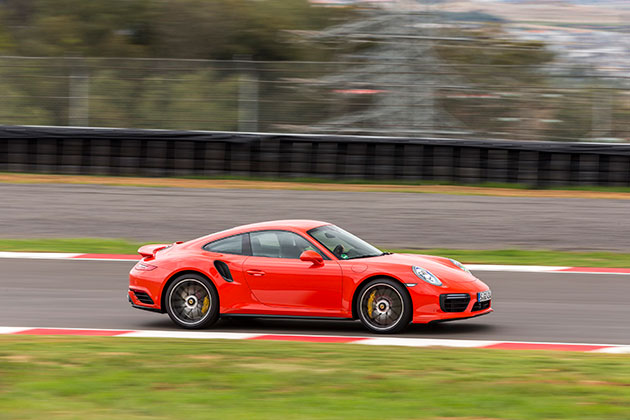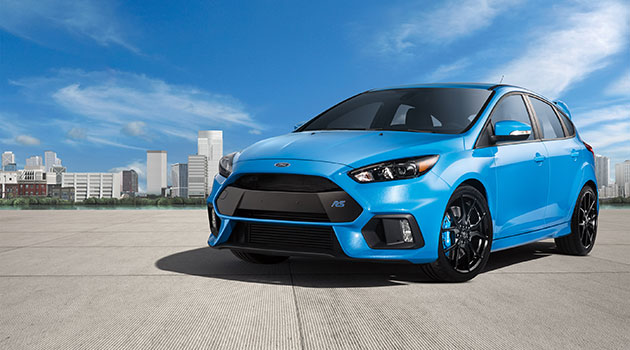Most superheroes don their capes proudly. Superman hides his away.
The original comic book crusader is unique in his humility, keeping his inherited powers in check to masquerade as the merely mortal Clark Kent in order to move freely through everyday life.
The 2018 Ford Focus RS may be able to relate.
Attached to a name that for two decades has mapped directly to a dependable-if-unremarkable automobile, the RS mostly flies under the radar.
But on the road, it just flies.
The hatchback version of the classic Ford model gets 350 horsepower on its six-speed transmission. It tops out at 165 MPH and can jolt from 0-60 in 4.5 seconds flat.
“It’s essentially a rally car with an interior,” said San Diego-based automotive technician Jonas Reilly. “It’s an animal. Those numbers are absolutely out of control.”
And, he added, the RS is not typically even considered a “fast” car today.
America’s autos are now swifter than ever, with average horsepower nearly doubling between 1967 and 2017, jumping from 145 to 283. And the time it takes to leap from 0 to 60 miles per hour has halved during that time, cut down from 14 seconds to an average of just seven last year.
The numbers put even the most muscular rides of the ‘60s and ‘70s to shame, with nearly any vehicle in today’s sea of rush hour homogeny capable of laying waste to the storied era’s classic hotrods.
But just as advancing technology has given auto enthusiasts a reason to cheer, it’s taken away an increasing number of lives on the road every year.
Distracted driving is also on the rise, feeding heavily into a roadway fatality rate that’s been breaking records since 2015.
And as our vehicles only continue to get faster, our attention spans only seem to keep shrinking.
Horsing Around
The horsepower horse race has been heating up for the last decade, as a confluence of technological advancements have led to engines that are not only stronger but smaller and smarter than most motors designed in the past.
“Modern robotics means you can build an engine that will go for 500,000 miles, as long as you change the oil,” Reilly said. “The car might dissolve around it, but the engine will still run.”
“Modern robotics means you can build an engine that will go for 500,000 miles, as long as you change the oil,” Reilly said. “The car might dissolve around it, but the engine will still run.”
That’s due to the impeccable and interminable fine-tuning being orchestrated by the car itself. Engine computer units (ECUs) have become increasingly sophisticated, with the chips now capable of overseeing and optimizing nearly every inch of a vehicle.
“There are a hundred different sensors on the car that measure, report back, and adjust accordingly,” Reilly said. “And they do this a thousand times a second.”
And even the smallest of adjustments can go a long way.
Carburetors, for example, were once essentially a one-size-fits-all item, pumping the same general mixture of gasoline and oxygen into an engine, regardless of whether it belonged to a tiny commuter vehicle or a roaring sports car.
But the electronically controlled fuel injection systems that have all but replaced carburetors in modern automobiles supply an engine with exactly what it needs—when it needs it.
Chain Gang
Modern-day ECUs have not only strengthened the circulatory systems of today’s cars; they’ve also sped up the fast-twitch muscles of the vehicles’ transmissions.
Newer cars are much more successful at staying in the “power band,” the range of revolutions per minute (RPMs) at which an engine can produce the most power possible—or, as Reilly put it, “the place the car is happiest.”
Most classic muscle cars maxed out at a 4-speed transmission, leaving far too much leeway between gears for an engine to efficiently hit or even find its stride. But modern vehicles—even automatics—can utilize seven gears or more, offering not only smoother transitions between speeds but also enough control to keep an engine in its RPM sweet spot.
The revolution revelation is responsible for the increasingly rapid jumps from 0-60—and is aided further by the lightning-fast mechanics of the ECU, which has slowly taken over more gear-changing duties, almost out of necessity.

The 2017 Porsche 911 Turbo S, for example, can make the 0-60 leap in just 2.6 seconds, a feat that would be physically impossible for a driver to replicate.
“It’s unholy,” Reilly said. “At that point, you’re shifting two or three gears in a fraction of a second. No human on earth can shift that fast.The time it takes just to step on the clutch would literally slow you down.”
But even the decidedly more pedestrian 2018 Toyota Camry can hit the cruising speed in 5.8 seconds, thanks to its 301 horsepower.
Compare that to the 1967 Ford Mustang GT—the quintessential muscle car—which needed 7.3 seconds to pull off the same feat. The classic came with several engine sizes. One option was capable of delivering up to 320 horsepower, though the standard model reached just 120. And owners still had to wrangle with a transmission that left much to be desired.
“If you got that car in 1967, it was most likely 3-speed, which means the engine was never where it needed to be to reach max power,” Reilly said. “So it had the capability, technically, to go faster, but it was always operating at a detriment.”
Herd Mentality
Race cars have long been privy to performance-enhancing technology allowing the machines to push the boundaries of speed, but the systems are increasingly making their way to the streets.
In 2016 alone, 18 available vehicle models could reach up to 600 horsepower. By 2017, that number climbed to over 30.
And Dodge topped even the wildest expectations of how fast a production car could go last year when it released the 2018 Challenger SRT Demon, which comes standard with 808 horsepower, can be upgraded to reach 840, and can soar from 0-60 in 2.3 seconds.
“We’re in the midst of a horsepower arms race,” Reilly said. “And it’s just becoming ballistic.”
Indeed, it’s not just the speed of our cars that’s exploding. Lightning-fast cell phones can bring all the world’s information to our fingertips before even a Dodge Demon could get from 0-60. And the temptation to interact with them has proven too hard to resist.
“With all the organizations out there promoting the message and all this great information, I’d like to think that [distracted driving] is becoming less and less of a problem,” said Danny Maher, Public Information Officer for the California Highway Patrol’s Coastal Division. “But we still have issues out there.”
Anything from eating to drinking to getting changed for work behind the wheel has been reported as the source of a distracted driving incident, Maher said, though cell phones are the perennial troublemakers.
That assessment holds true outside of California, as well. The number of drivers who admitted to using their phone behind the wheel “regularly or fairly often” jumped by 46% since 2013 in one AAA study. Nearly half of the participants said they had recently talked on a handheld phone while driving, and 35% copped to recently texting while driving.
“We always tell people that you cannot use your cell phone while driving,” Maher said. “Now they have the hands-free devices, and most are even built into the cars now, but to me, it’s not holding your phone, but having the conversation itself that’s distracting.”
It’s also deadly. In 2016 alone, 3,450 people were killed in accidents caused by distracted driving. The incidents made the difference—and more—in the overall growing number of roadway fatalities that year, which totaled 37,461.
But as grim as the situation may look, the solutions to it are myriad—and may be simpler than we think, Maher said.
“Vehicles are becoming more technologically sound, and there are so many devices that are supposed to keep us from becoming distracted, but they’re inadvertently making us more distracted than ever,” he said. “It pulls our attention away from what we’re doing rather than helping us out. So I would recommend, before you back out of the driveway or even set the car in motion, justget everything where you need it, get everything where you want it, and don’t touch it again until you get where you’re going.”
